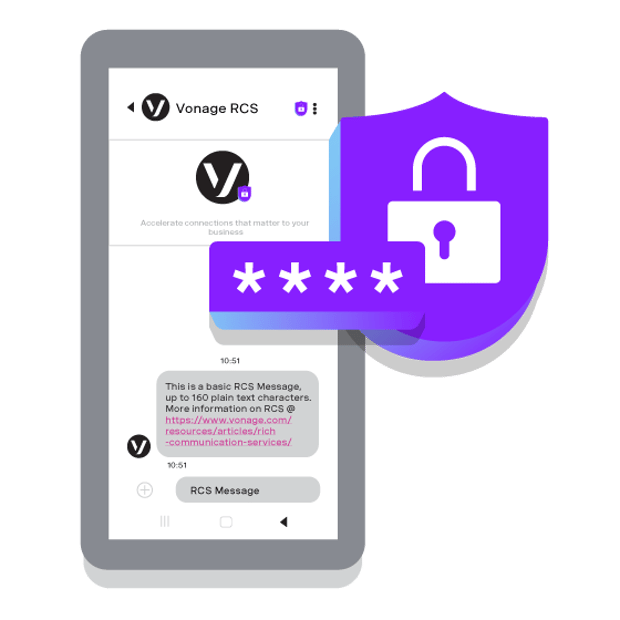How Secure Messaging With RCS Builds Customer Trust
Customer trust has never been more crucial to business success. According to Zendesk, 83% of consumers say they will not do business with brands they don't trust. Although customers appreciate the convenience of interacting with businesses through short message services (SMS) text messages, the rise in text-based scams and phishing attempts has compromised their trust in this communications channel.
Businesses need to keep the convenience and immediacy of text messaging, while providing secure messaging that protects customers and earns their valuable confidence. Rich communication services (RCS) messaging, which is available to Android users and Apple customers using iOS 18.1 or better*, makes it possible to achieve both goals at once. Here's what businesses need to know about RCS, how it can increase customer trust and brand authenticity, and the many other ways it can enhance customer communications.
Explore Vonage Rich Communication Services
The trust challenge in modern business messaging
When it comes to customer engagement, businesses have two major challenges to address. First, they have to make sure their messages reach customers. Second, when messages arrive, they must be presented in a way that increases customer trust while enhancing security. Traditional SMS messaging is widespread, and as a result, most customers know how to use it, but it has become increasingly vulnerable to fraud and abuse.
Seventy-five percent of organizations worldwide were targeted by smishing attacks in 2023, according to a Statista survey. As generative AI makes it even easier for cyber criminals to launch their deceptive texting campaigns, smishing could become even more rampant. Businesses and consumers alike have reason to be concerned about how to maintain trust in this environment.
Unfortunately, because SMS doesn't provide built-in authentication methods, businesses can't easily prove they are who they say they are when reaching out to customers via traditional text messages. Since SMS text messages are short in length, it can be hard to distinguish a somewhat cryptic but legitimate message from a fraudulent one. If your company is sending a one-way message, then customers might see your company name (also known as an alphatag). But if you’re using two-way communications, they only see a short code or a phone number in the sender field. Accordingly, they might not readily trust that the message came from an authentic source.
Customers are weary of having to play detective and figure out whether each message they receive is the real deal. They’re less likely to click on links arriving via SMS due to security concerns. Customers want immediate verification of each message they receive, they expect visual confirmation of the sender's identity, and they seek assurance that their conversations are secure. This is especially true for exchanges involving purchases, personal information, account updates, or financial transactions.
If customers can't easily determine whether a message is authentic, they're likely to delete it or flag it as spam. Or, at best, they'll simply leave it unread. Accordingly, businesses need a messaging channel that provides robust security features while preserving the immediacy and convenience that made SMS such a popular form of communication.
RCS enhances security and trust in customer communications
Rich communications is the new default messaging standard that mobile carriers are rolling out worldwide to modernize how businesses communicate with their customers. Unlike specialized messaging apps that customers have to download and learn how to use, RCS comes built right into their phone’s default messaging app. Already serving more than 1 billion users globally and rapidly growing, RCS is quickly becoming the natural way for businesses to connect with customers via the messaging channel they use every day.
Rich communication services, an enriched form of business messaging, can directly address these urgent security and trust issues by completely changing how businesses and their branding appear on customers' mobile devices. Instead of relying on numerical codes that aren't meaningful to customers and can be faked, RCS messages arrive with full business branding that is verified by mobile carriers — trusted intermediaries that customers already rely on for their communications. This carrier-verified branding includes business names, logos, and sender verification badges that confirm authenticity.
RCS uses an enterprise-grade secure messaging infrastructure based on a new global standard. This infrastructure includes a verified sender system that helps reduce smishing fraud. When a business wants to begin messaging customers using RCS, it must first undergo a careful verification process. This best practice creates a trusted environment in which customers can recognize that an incoming message is legitimate without having to scrutinize it for signs of fraud or deception.
Of course, security involves more than branding and authentication. That's why RCS also supports end-to-end encryption* for messages, which helps shield customer conversations from unauthorized third parties even if they fall into the wrong hands. Businesses that handle personal data or conduct transactions will find this improvement over SMS especially valuable.
In addition to powerful encryption, RCS offers embedded security features that add layers of protection. Businesses can include interactive buttons that link to verified URLs, allowing customers to safely engage with their content. These buttons can be programmed to clearly indicate their purpose, such as to schedule an appointment or complete a purchase, increasing customer confidence and engagement rates. Businesses can also revoke messages after they've been sent via RCS, which gives them crucial flexibility in the event of a security incident or even if they've simply caught an honest mistake in their messaging.
One of the aspects that makes RCS so engaging from a customer standpoint is the security benefits. RCS allows businesses to send visually rich communications that align with their brand identity, including interactive elements like buttons, suggested replies, and calendar integration. These elements, which natively appear within the customer's default messaging app on their phone, minimize the need to click on potentially suspicious external links.
